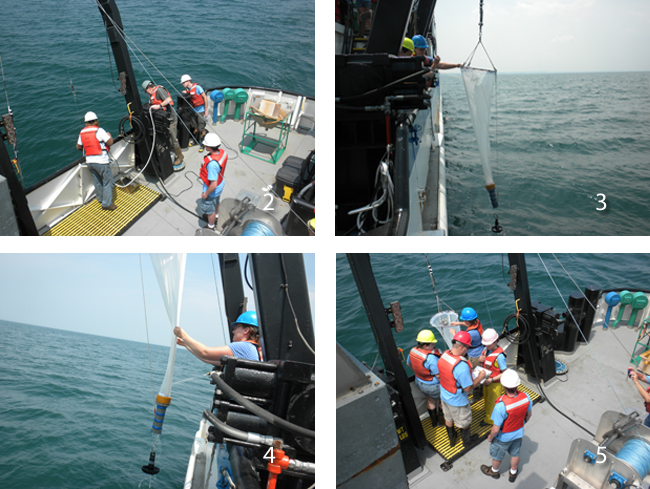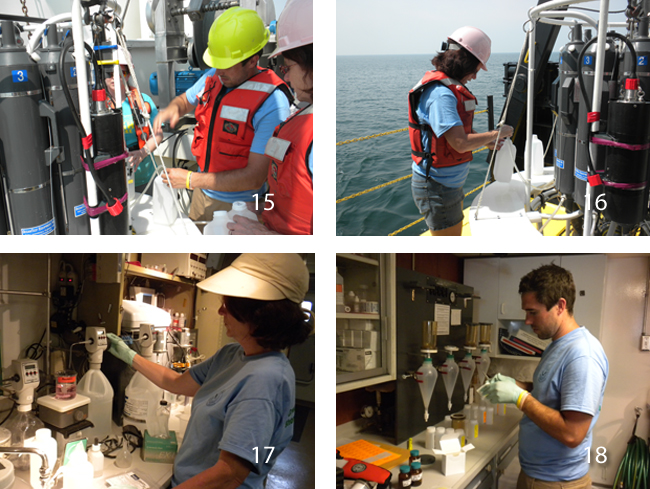WEDNESDAY, JULY 10, 2013
Educators Draw Water and Soil Samples and Make
Observations on Lake Ontario's Chemistry and Critters At Some 16 Stops in a Marathon Two Day Expedition
 This and all photos below: Paul C. Focazio, NYSG
This and all photos below: Paul C. Focazio, NYSG
Over the course of the first full two days alone, those aboard are taking shifts during both the day and night to sample some 16 locations in Lake Ontario's waters. Additional sites will be studied later in the week.
At each of these field stations, water, mud and bottom sediment samples are being drawn by teachers with assistance from
State University of New York College of Environmental Science and Forestry's
Dr. Greg Boyer and
New York Sea Grant’s Coastal Education Specialist
Helen Domske, among others. Stations range from offshore to nearshore locales including Toronto, Oswego and Rochester. Samples drawn at the variety of stops will help the team of teachers and investigators to make some assessments, such as: What is the difference between the eastern and western Lake Ontario basin? And, how does the nearshore compare with offshore waters?
One of the sampling techniques involves the use of a
plankton net (
pictured above [1] and below [2-9]). These biological studies provide a "vertical snapshot" of the water column and involve counts of microscopic phytoplankton — photosynthetic organisms like green algae, cyanobacteria, diatoms and dinoflagellates — and zooplankton, a primary food source for Great Lake sportfish such as walleye and yellow perch. At stations where samples are drawn at shallower depths (10 - 20 meters deep) are where phytoplankton will be abundant, while zooplankton would be expected more in samples taken at deeper depths (down at 80 meters or more below the Lake's surface).


Once the plankton nets are pulled back up from their designated depths, a sample is extracted from the plastic tube (
seen above [6]) and placed in a jar (
seen below [7-9]). These water samples are analyzed in the on-board laboratories along with all the other samples drawn at each station.



A
Secchi disc (
pictured below [10- 11]) is used to determine the water’s turbidity, a measure of clarity. The disc is mounted on a pole or line, and lowered slowly down in the water. The depth at which the pattern on the disk is no longer visible is taken as a measure of the transparency of the water. This measure is known as the Secchi depth and is related to water turbidity.
The original Secchi disk was all-white. Today, most disks used in lakes have alternating black and white quadrants, while marine disks are usually all-white. The reasons for the difference is not clear, and may be more historical than theoretical — maybe that's why the ones aboard the R/V Lake Guardian measuring the waters of Lake Ontario and the other Great Lakes are all-white instead of black and white. Early disks of the 19th century were all white, but, in 1899, George C. Whipple stated that a disk with alternating black and white quadrants was more easily seen, and "Whipple's" disk became the standard in freshwater situations.


Water samples are drawn (using a
Rosette sampler,
as seen, below, [12 - 16]) at the various “stations” along the lake (and at different depths — surface, thermocline and one meter off the lake bottom) to analyze chemistry and water quality — factors such as surface temperature, dissolved oxygen, pH, and fluorescence (a measure of algae abundance).




The samples drawn at each station via the Rosette sampler are then brought into the
R/V Lake Guardian's on-board laboratory, where a series of tests are conducted to determine the Lake Ontario water's temperate, pH, turbidity, alkalinity, conductivity, hardness (amount of Calcium), and nutrient levels (Phosphorus, Nitrogen, Silica).

A
Ponar grab (
below, [20-21]) helps to pull up mud samples (
below, [22]) for biologial studies of the Lake’s benthic animals, including worms, snails, crustaceans (shrimp-like creatures) and chironomids (midge fly larvae) ...



... But, as you’ll also see below
[23-25], what comes up most are Zebra and
Quagga mussels, which NYSG's Helen Domske helps to identity for the
educators
[24-25].



While filter-feeder activities of these exotic Quagga and Zebra mussel have helped to increase the Lakes’ water clarity, that in itself has introduced more concerns. For example, clearer water allows more light to penetrate, which in turn makes it more conducive for algae, like the pervasive
Cladophora, to thrive, especially in warmer temperatures.
“The problem with
Cladophora in Lake Ontario and other coastal waters,” says Domske, “is that when storms cause it to break off, dead sections of the plant pile up near the shore, where they rot and create an anoxic, or low-oxygen environment for bacteria to thrive – including botulism. botulism outbreaks have killed thousands of fish and waterfowl.”
While the sight of
Cladophora may not be pleasant to visitors of the shoreline, it is not harmful to humans. For more on this and other algae, see the July 9, 2013 blog post, "
Safety First: But, Are They Harmful?"

After all of the benthic animals are removed and identified from each Lake-bottom mud sample, the educators and crew of the R/V Lake Guardian empty the contents of the ponar grab sampler into a stainless box (
pictured above, [26]) and rinse the grab sampler with a hose to make sure that all of the sample is rinsed into the stainless steel box (
pictured below, [27]) and then out through a mesh tube (
pictured below, [28]) and into a plastic container (
pictured below, [29]). The bottom sample is now ready for examination in the laboratory.


